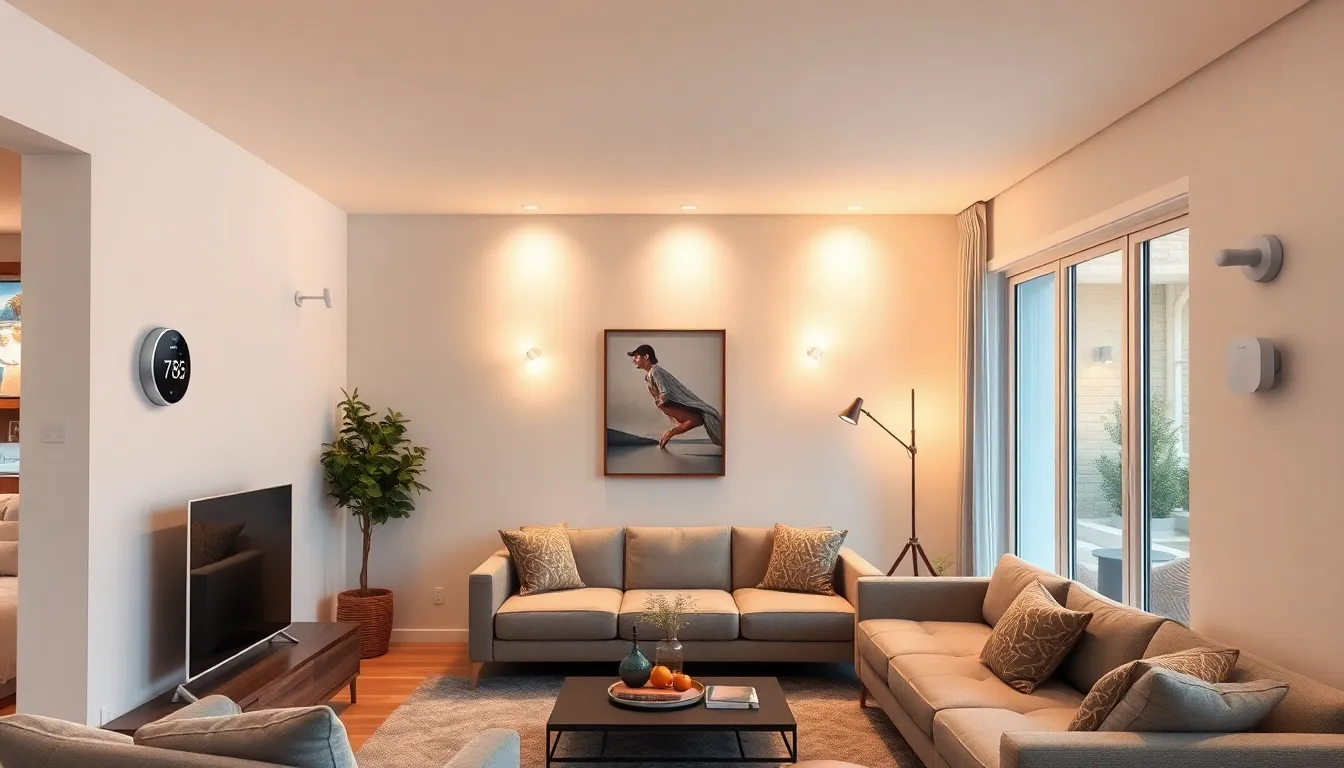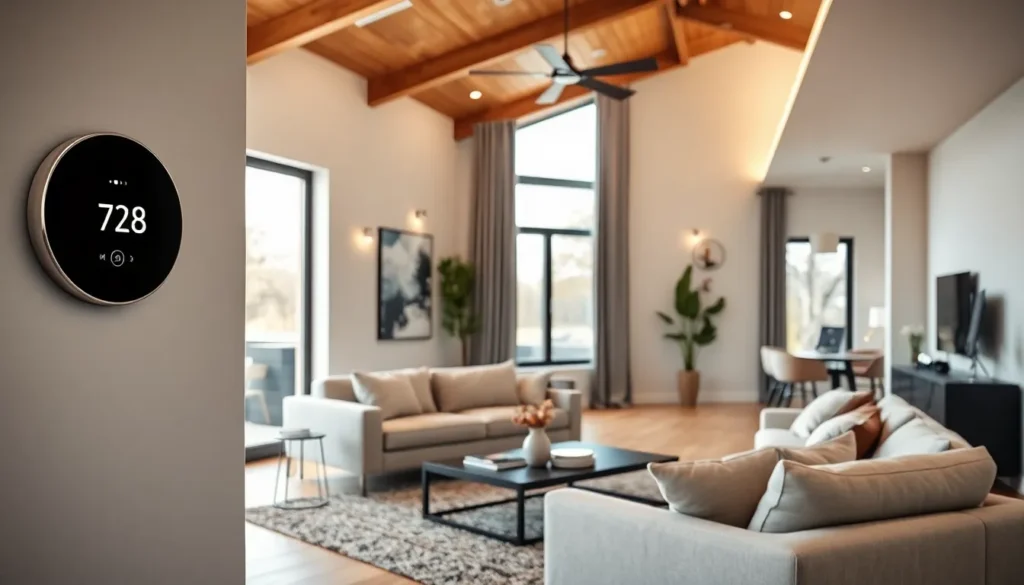Table of Contents
ToggleThe concept of a smart home is revolutionizing the way people interact with their living spaces. With technology advancing at lightning speed, homes are becoming more connected and intuitive, allowing for seamless integration of devices and systems. From automated lighting to smart thermostats, these innovations not only enhance convenience but also promote energy efficiency.
As homeowners embrace this digital transformation, the benefits extend beyond mere gadgets. Smart home technology offers enhanced security, improved comfort, and even potential cost savings. Understanding how these systems work and their impact on everyday life is essential for anyone looking to upgrade their living environment. In this article, readers will discover the key components of smart homes and learn how to create a more connected and efficient household.
Overview of Smart Homes
Smart homes integrate advanced technology to enhance the living experience, making daily tasks simpler and more efficient. They rely on a combination of connected devices, communication systems, and automation to improve convenience and control.
Key Components
- Smart Lighting: Automated systems adjust brightness based on time of day or occupancy.
- Smart Thermostats: Learning algorithms optimize heating and cooling, resulting in energy savings.
- Security Systems: Connected cameras, smart locks, and alarms provide real-time monitoring and control.
- Home Assistants: Devices like Amazon Echo or Google Home enable voice-activated control of various smart functions.
Benefits
- Convenience: Smart devices enable remote access. Users can control appliances from smartphones or other devices.
- Energy Efficiency: Automated systems help lower energy consumption. Smart technologies can track usage patterns.
- Enhanced Security: Real-time alerts and video feeds provide peace of mind. Homeowners can monitor their properties from anywhere.
- Cost Savings: Reduced energy bills result from optimized usage. Many smart devices also offer scalable solutions to fit any budget.
Future Trends
As technology progresses, smart homes continue to evolve. Innovations like artificial intelligence and enhanced connectivity promise even greater intelligence and efficiency. Homes will likely become more responsive to individual preferences, making daily living more customizable.
Benefits of Smart Home Technology

Smart home technology offers numerous advantages that significantly improve daily living. Key benefits include improved energy efficiency and enhanced security features.
Improved Energy Efficiency
Smart home devices optimize energy usage, leading to reduced energy bills and a lower carbon footprint. Smart thermostats learn household patterns and adjust heating or cooling based on occupancy, resulting in energy savings of up to 30%. Automated lighting systems utilize sensors to reduce power consumption by turning off lights in unoccupied rooms. Additionally, smart appliances, such as energy-efficient ovens and washers, operate during off-peak hours to further decrease energy costs. These technologies contribute to more sustainable living.
Enhanced Security Features
Smart home security systems provide real-time monitoring, offering increased peace of mind. Surveillance cameras with motion detection alerts homeowners of unusual activity, enhancing safety. Smart locks allow secure remote access, enabling users to control entry points from anywhere. Integration with alarm systems ensures immediate notifications in case of breaches. These features not only deter potential intruders but also provide homeowners with detailed insights into security events.
Popular Smart Home Devices
Smart home devices enhance convenience and security within residences. Here are some popular options that contribute to a smarter living experience.
Smart Lights
Smart lights offer programmable settings and voice control capabilities. Homeowners can adjust brightness, color, and schedules remotely via smartphone apps or home assistants. Brands like Philips Hue and LIFX lead the market, providing energy-efficient LED bulbs that help reduce overall electricity use.
Smart Thermostats
Smart thermostats improve energy efficiency through adaptive learning. They adjust heating and cooling based on occupancy patterns, optimizing energy consumption. Devices from companies like Nest and Ecobee provide remote access and detailed energy reports, leading to potential savings of up to 15% on heating and cooling costs.
Smart Security Systems
Smart security systems enhance home safety with features like real-time monitoring and alerts. These systems include cameras, doorbell cameras, and motion detectors that connect to smartphones. Popular brands like Ring and Arlo offer user-friendly interfaces that allow homeowners to monitor their property from anywhere, significantly improving peace of mind.
Challenges and Concerns
Smart home technology presents various challenges and concerns, particularly regarding privacy and costs. Understanding these issues is essential for potential users when considering the integration of smart devices into their homes.
Privacy Issues
Privacy remains a significant concern in smart home ecosystems. Many devices collect personal data to enhance user experience, but this data collection can expose individuals to risks. Devices like smart speakers and security cameras often require access to personal information, leading to potential misuse or unauthorized access. Cybersecurity threats, including hacking and data breaches, can compromise sensitive user data. Implementing strong security protocols, like regular software updates and using secure passwords, helps mitigate these risks, but it’s crucial for users to stay vigilant about their privacy.
High Initial Costs
High initial costs represent another barrier for smart home adoption. Installing a range of smart devices often involves substantial investment, particularly for comprehensive security systems, smart appliances, and advanced automation features. While these devices provide long-term savings through energy efficiency and convenience, the upfront expenses can discourage potential users. Homeowners must budget effectively to integrate smart technology gradually, considering both the immediate costs and potential future savings to make informed decisions.
Future Trends in Smart Homes
Smart homes are poised for significant advancements driven by emerging technologies. Key trends shaping the future include:
- Artificial Intelligence (AI) Integration: AI will enable devices to learn user preferences, enhancing automation. Smart homes will seamlessly adapt to individual routines, optimizing energy use and improving comfort.
- Enhanced Connectivity: The growth of 5G technology will facilitate faster and more reliable connections for smart devices. Homes will support higher data throughput, allowing more devices to function concurrently without lag.
- Interoperability: Manufacturers are prioritizing compatibility among devices. Smart products from different brands will increasingly communicate, creating a unified smart home ecosystem. This trend simplifies user experiences and enhances system efficiency.
- Energy Management Solutions: Smart homes will focus on real-time energy monitoring. Advanced systems will provide insights into consumption patterns, enabling users to optimize usage and lower utility bills. Eco-friendly practices will become integrated into everyday living.
- Health and Wellness: Smart technologies will enhance home environments by monitoring air quality, humidity, and temperature. Health-focused devices will promote well-being, helping residents maintain optimal living conditions.
- Voice and Gesture Control: Voice recognition and gesture-based controls will gain traction. Users will interact with their homes through natural language and movements, making control intuitive and accessible.
- Sustainable Solutions: Smart homes will integrate renewable energy sources, such as solar panels. Innovations will enhance energy efficiency and support eco-friendly living, appealing to environmentally conscious consumers.
- Robotic Assistants: The introduction of more sophisticated robotic assistants will change daily routines. These robots will handle chores, providing convenience to homeowners and allowing them to focus on other tasks.
These trends indicate a future where smart homes become increasingly integrated, efficient, and attuned to individual needs and preferences. Innovations in technology will drive the evolution of smart homes, making them more responsive and user-friendly.
Smart home technology is reshaping the way individuals experience their living environments. With advancements in automation and connectivity, homes are becoming more intuitive and efficient. The benefits of enhanced security and energy savings are undeniable, making smart devices an attractive option for many homeowners.
As technology continues to evolve, the future of smart homes holds even more promise. Innovations like AI and improved connectivity will lead to greater personalization and convenience. While challenges such as privacy concerns and initial costs remain, the long-term advantages of smart living make it a worthwhile investment. Embracing smart home technology not only simplifies daily tasks but also contributes to a more sustainable and secure lifestyle.







